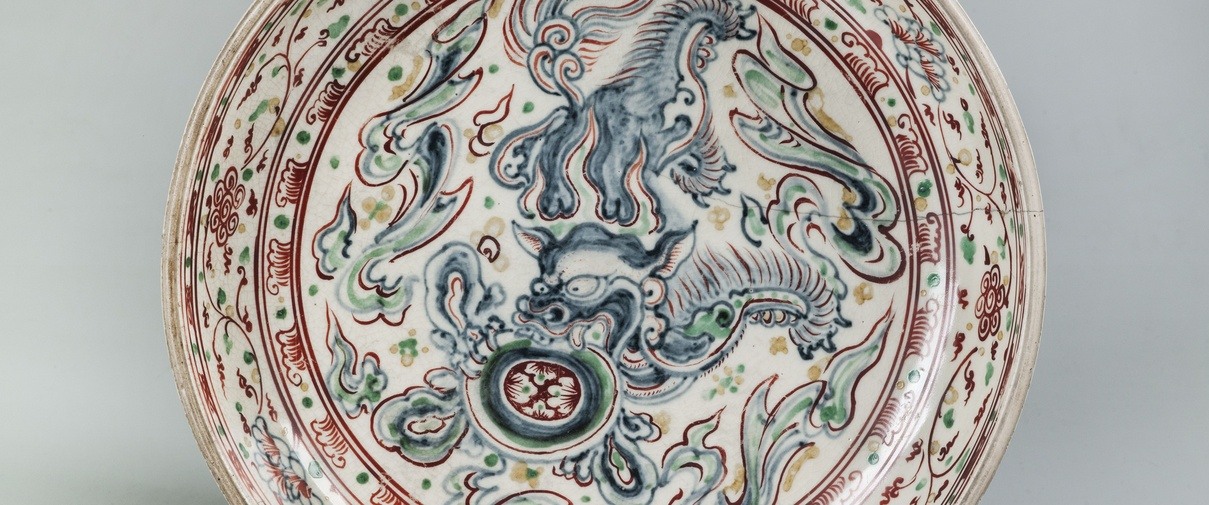Dish with decoration of dragon and pearl, Than Hoa, Vietnam, approx. 1500 – 1520, stoneware, 32.2 x 7.2 cm, Princessehof National Museum of Ceramics.
The bowl was produced in the area of the Red River Delta in the north of Vietnam. The capital Hanoi is located here and it has traditionally been an important area with a lot of activity, where a lot of trade was done. Because Vietnam borders China, this country came into contact with Chinese art and culture on a regular basis, and this had an effect on the local traditions. This is reflected in the ceramics. Certain shapes and decorations, such as the dragon and the phoenix, have clear similarities with the Chinese versions.
In the thirteenth century, the Mongols came to power in China. This period is called the Yuan Dynasty (1279-1368). The Mongols also conquered large parts of West and Central Asia, areas that had been Islamic since the seventh century. This had an effect on Chinese ceramic production: during the Yuan, typical Islamic shapes and decorations became popular. These ceramics were in great demand in Islamic areas.
Another successful market was Southeast Asia. Here too, Islam had spread on a large scale, which meant that the local food culture became interwoven with Islamic traditions. Large bowls for serving food became a much sought-after item. In both China and Vietnam, this type of ceramic was made especially for this market. In Indonesia and Malaysia, people preferred colourful bowls. The bowl from the Princessehof collection is a good example of this. In the middle of the bowl, a dragon can be seen chasing a pearl. We also see this decoration a lot on Chinese ceramics, but this dragon is typically Vietnamese. This is visible in the loose but powerful painting that brings it to life. The effect is more playful than the examples from China.
Many of these bowls eventually became cherished family heirlooms (pusaka) and were given a spiritual value over time. In the nineteenth century, when Indonesia was still a colony of the Netherlands, travellers took many of the bowls home with them. This example eventually ended up in the museum's collection.
Hoi An
In 1993, a shipwreck was found near Hoi An in Vietnam. When a few fishermen were pulling up their nets, they noticed that pieces of ceramics had been caught in the catch. They reported their catch to the authorities, who suspected that they were remains from the cargo of a shipwreck. A search was set up to locate the ship. It turned out to be about thirty-five kilometres off the coast of Hoi An. The wreck was found at a depth of seventy metres. This made it very difficult to raise the ship and its cargo. In 1996, a project was set up by businessman Ong Soo Hin to excavate it. It ultimately took four years to get everything above water. The project cost around 14 million dollars. Eventually, 250,000 pieces of ceramics emerged intact from the wreck. An enormous amount! All the unique pieces were added to the collections of museums in Vietnam. The majority of the find was auctioned in San Francisco in 2000. The cargo includes a large quantity of Vietnamese ceramics from the Red River Delta area. Since the ship can be dated around the late fifteenth, early sixteenth century, the cargo must also be from around that period. This provides an enormous basis for dating Vietnamese ceramics in other collections, including those in the Princessehof, which can now be done more precisely on the basis of stylistic similarity than was the case before the discovery of the Hoi An wreck.
Eline van den Berg, curator Asian ceramics at Princessehof National Museum of Ceramics.
